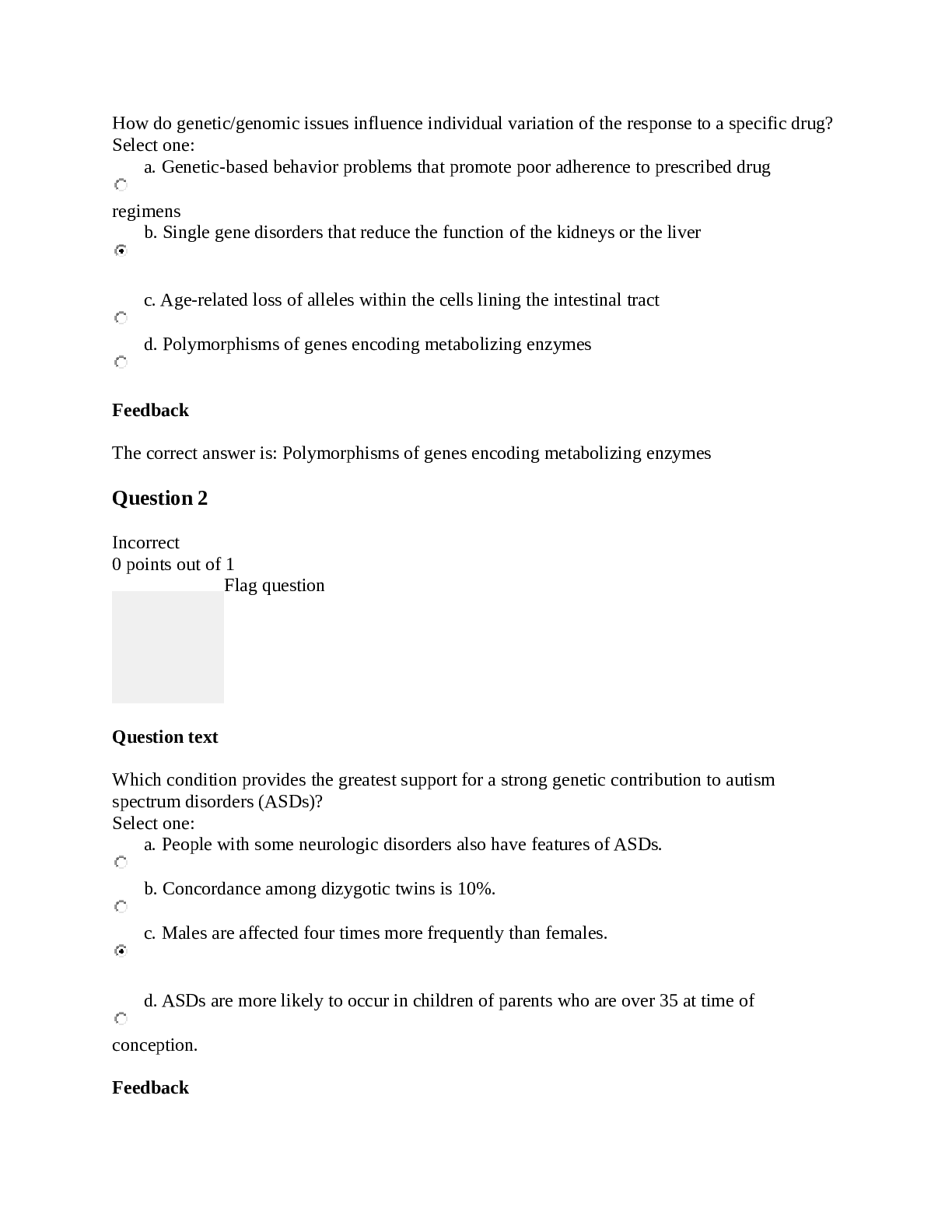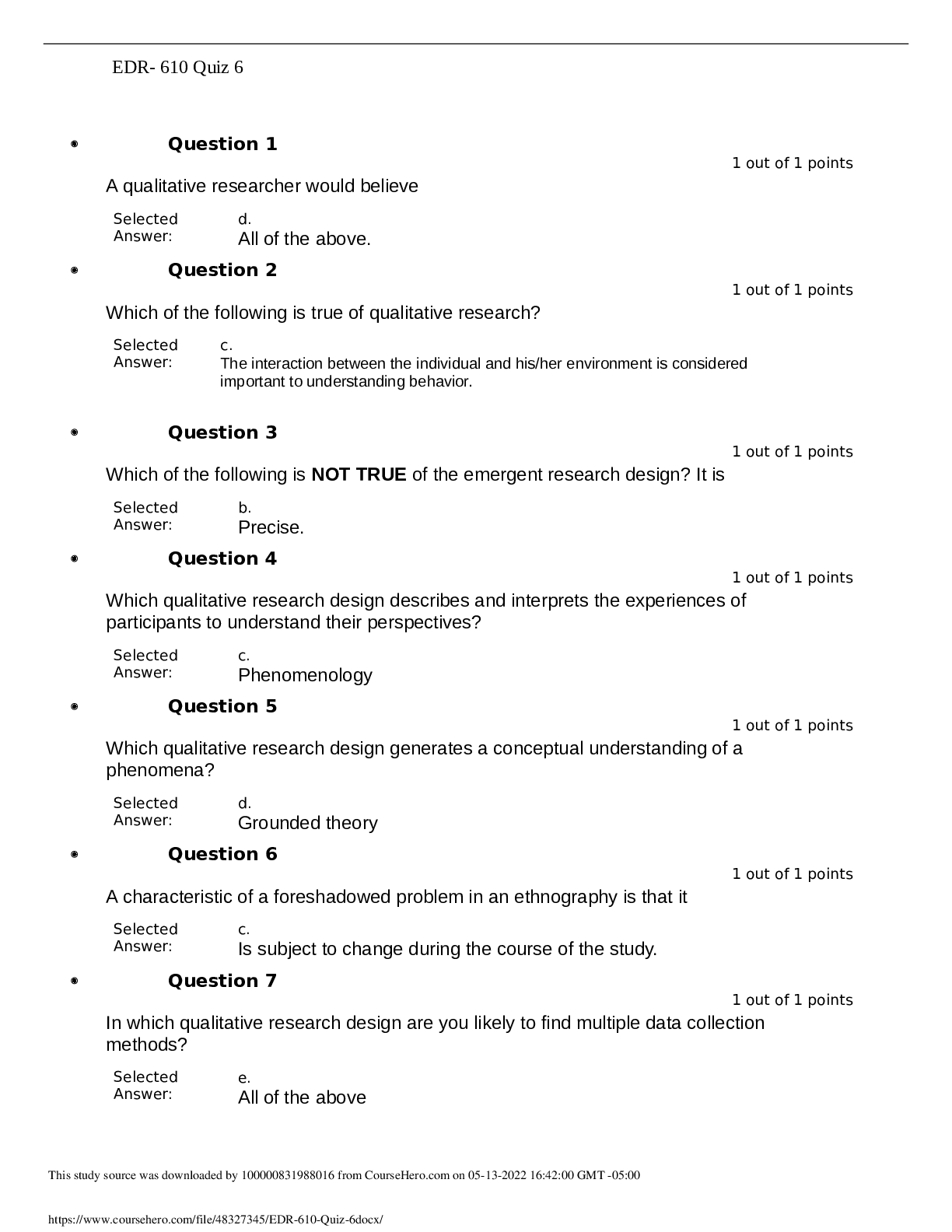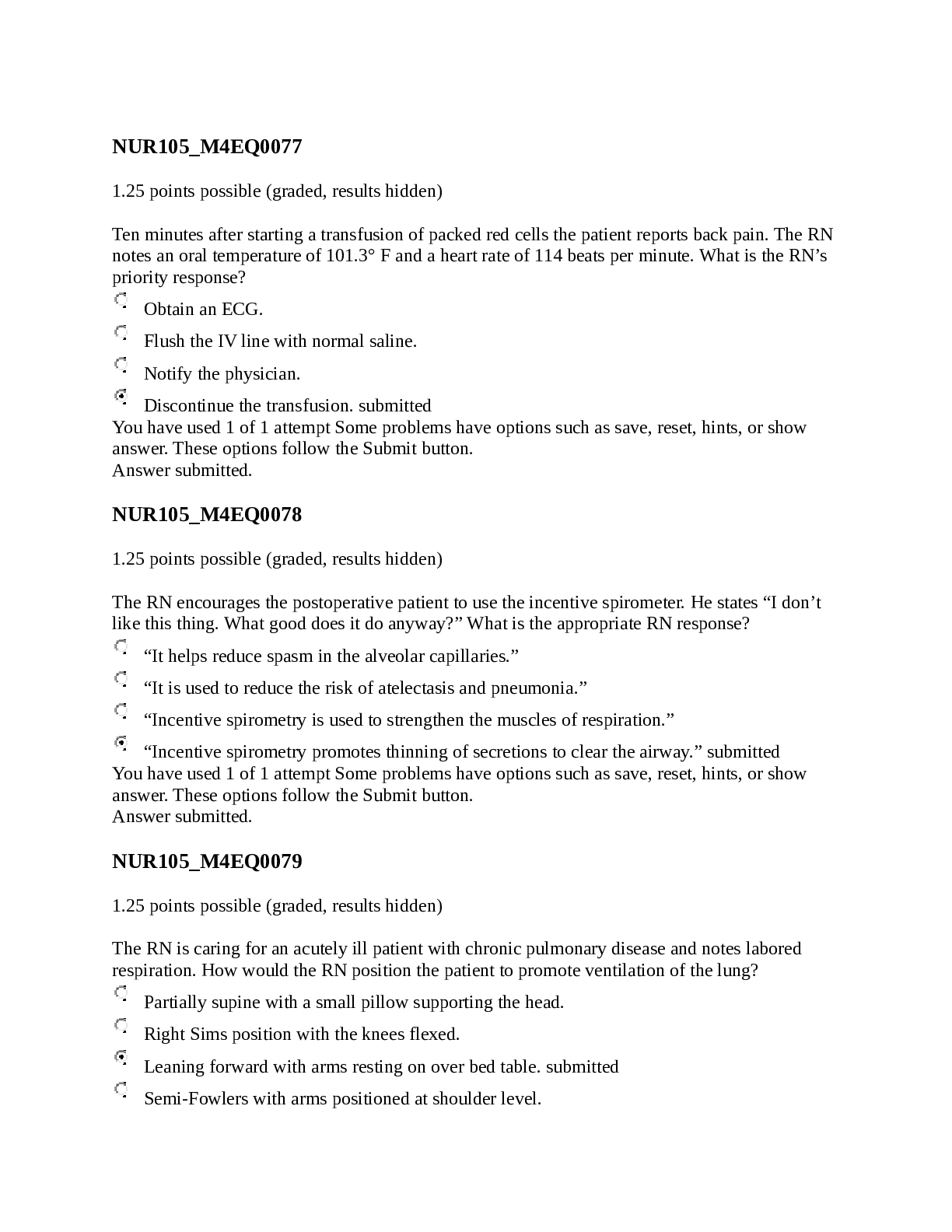Health Care > EXAM > CPCE Counseling and Helping Relationships Exam 138 Question with Answers,100% CORRECT (All)
CPCE Counseling and Helping Relationships Exam 138 Question with Answers,100% CORRECT
Document Content and Description Below
CPCE Counseling and Helping Relationships Exam 138 Question with Answers Alfred Adler - CORRECT ANSWER Theorist that created individual psychology; emphasized the drive for superiority; one of th... e first therapists to rely on paradox Eric Berne's transactional analysis (TA) - CORRECT ANSWER (Berne) a system of popular psychology based on the idea that one's behavior and social relationships reflect an interchange between parental (critical and nurturing), adult (rational), and childlike (intuitive and dependent) aspects of personality established early in life Free association - CORRECT ANSWER instructing the client to say whatever comes to mind Directive counseling - CORRECT ANSWER counseling technique in which the client is asked to discuss certain material Josef Breuer - CORRECT ANSWER His work in the 1880s with his patient Bertha Pappenheim, known as Anna O., developed the talking cure (cathartic method) and laid the foundation to psychoanalysis as developed by his protégé Freud Psychodynamic counseling - CORRECT ANSWER This type of therapy does not use the couch, is performed face to face, and utilizes fewer sessions per week Catharsis and/ or abreaction - CORRECT ANSWER A curative process in which one talks about difficulties in order to purge emotions and feelings Reflection of emotional content - CORRECT ANSWER When the counselor restates the client's verbalization in such a manner that the client becomes more aware of their emotions Parapraxis (Freud) - CORRECT ANSWER (Freud) Slip of the tongue Subjective units of Disturbance Scale (SUDS) - CORRECT ANSWER A concept used in forming a hierarchy to perform Wolpe's systematic desensitization Preconscious mind - CORRECT ANSWER Capable of bringing ideas, images, and thoughts into awareness with minimal difficulty (ex. taking just a few minutes) Unconscious mind - CORRECT ANSWER Composed of material which is normally unknown or hidden from the client Reaction formation - CORRECT ANSWER a behavior in which a person behaves in a manner opposite to the way they truly feel defense mechanism in which unacceptable impulses are transformed into their opposite Repression - CORRECT ANSWER unconsciously keeping distressing thoughts and feelings buried in the unconscious; most important defense mechanism Sublimation - CORRECT ANSWER the transformation of unacceptable impulses into socially valued motivations (ex. aggressive person becomes a boxer) Suppression - CORRECT ANSWER A conscious effort to put something out of mind or to keep it from awareness Displacement - CORRECT ANSWER defense mechanism in which feelings about one person are transferred to someone else Introjection - CORRECT ANSWER Unconsciously incorporating values and attitudes of others as if they were your own Sour grapes rationalization - CORRECT ANSWER belittling what you fail to achieve Sweet lemon rationalization - CORRECT ANSWER convincing yourself that you are just as well off without whatever you failed to achieve Identification - CORRECT ANSWER results when a person identifies with a cause or a successful person with the unconscious hope that he/she will be perceived as successful or worthwhile Resistance - CORRECT ANSWER Client's tendency to inhibit or fight against the therapeutic process Totem (Freud) - CORRECT ANSWER (Freud) An object that represents a family or group Taboo (Freud) - CORRECT ANSWER (Freud) the dread of incest Interpretation - CORRECT ANSWER making the clients aware of their unconscious processes Organ inferiority - CORRECT ANSWER the insight of being deficient or somehow lesser than other people as a outcome of aversive emotions about a physical attribute. Logos - CORRECT ANSWER Implies logic Eros - CORRECT ANSWER Implies intuition Mandala - CORRECT ANSWER A sacred geometric circular figure that represents the universe; used by Jung Constructivist theorist - CORRECT ANSWER These theorists stress that is it imperative that we as helpers understand the client's view (also known as constructs) to explain their problems Neo-Freudians - CORRECT ANSWER These type of theorists emphasized social factors (Adler, Erikson, Sullivan, Horney) Rudolf Dreikurs - CORRECT ANSWER The first to discuss the use of group therapy in practice Social Connectedness (Adler) - CORRECT ANSWER (Adler) people's wish to belong The collective unconscious (Jung) - CORRECT ANSWER (Jung) Implies that all humans have "collected" universal inherited, unconscious neural patterns Paradoxical interventions (Frankl) - CORRECT ANSWER (Frankl) often the direct antithesis of common sense directives; client is instructed to intensify or purposely engage in the maladaptive behavior Archetype (jung) - CORRECT ANSWER (Jung) a primal universal symbol, which means the same thing to all men and women (i.e. the cross) Symtom substitution - CORRECT ANSWER A psychoanalytic concept that states if you deal with the symptom, another symptom will manifest itself since the real problem is in the unconscious mind Eclectic counselor - CORRECT ANSWER a counselor that attempts to choose the best theoretical approach based on the client's attributes, resources, and situation; also associated with Frederick Thorne Associationism - CORRECT ANSWER Asserts that ideas are held together by associations Law of effect (Thorndike) - CORRECT ANSWER (Thorndike) asserts that responses accompanied by satisfaction will be repeated, while those which produce unpleasantness or discomfort will be stamped out Delayed conditioning - CORRECT ANSWER When the CS is delayed until the US occurs Trace conditioning - CORRECT ANSWER When the CS terminates before the occurrence of the US Stimulus generalization (aka second-order conditioning) - CORRECT ANSWER Occurs when a stimulus similar to the CS produces the same reaction Experimental neurosis - CORRECT ANSWER When the differentiation process becomes too tough because stimuli are almost identical extinction - CORRECT ANSWER the gradual weakening and disappearance of a conditioned response tendency Spontaneous recovery - CORRECT ANSWER the return of a learned response at some time after extinction has occurred Chaining - CORRECT ANSWER A behavioristic term; a sequence of behaviors in which one response renders a cue that the next response is to occur Baseline - CORRECT ANSWER Indicates the frequency of the behavior untreated Neil Miller - CORRECT ANSWER showed that by utilizing rewards, rats could be trained to alter their autonomic responses (i.e. heart rate, intestinal contractions, blood pressure) Edward Thorndike - CORRECT ANSWER Postulated the "law of effect" Law of effect - CORRECT ANSWER Thorndike's rule that behaviors which have positive outcomes tend to be repeated Paradigm - CORRECT ANSWER another term for counseling "model" Nondirective approach - CORRECT ANSWER an approach where the counselor allows the client to explore thoughts and feelings with a minimum of direction; initially popularized by Rogers Directive approach - CORRECT ANSWER An approach where the therapist leads the client to discuss vertain topics and provides "direct suggestions" about how the client should think, act, or behave Concreteness - CORRECT ANSWER An approach in which the counselor attempts to eliminate vague language Biofeedback - CORRECT ANSWER provides the client and helper with biological information such that the client can master self-regulation Operant - CORRECT ANSWER And behavior which is not elicited by an obvious stimulus Respondent - CORRECT ANSWER the consequence of a known stimulus Higher-order conditioning - CORRECT ANSWER When a new stimulus is associated or "paired" with the CS and the new stimulus takes on the power of the CS Token - CORRECT ANSWER something which represents a reinforcer; can be exchanged for the primary (i.e. actual) reinforcer Temperature training - CORRECT ANSWER raising the temperature of a hand to ward off migraines EMG Feedback - CORRECT ANSWER measuring muscle tension Premack Principle - CORRECT ANSWER commonly occurring behavior can reinforce a less frequent behavior EEG Feedback - CORRECT ANSWER Used to secure feedback related to brain wave rhythms continuous reinforcement - CORRECT ANSWER when a reinforcer is given every time a desired response occurs thinning - CORRECT ANSWER The process of gradually decreasing reinforcement given for a particular behavior. VR (variable ratio), VI (variable interval), FR (fixed ratio, FI (fixed interval) - CORRECT ANSWER Schedules of reinforcement, from most to least effective Yerkes-Dodson Law - CORRECT ANSWER Stipulates that a moderate amount of arousal actually improves performance secondary reinforcement - CORRECT ANSWER a stimulus which accompanies a primary reinforcer takes on reinforcement properties of its own Covert - CORRECT ANSWER behavior that is not observable (ex. thought or visualization) back-up reinforcer - CORRECT ANSWER an item or activity which can be purchased using tokens in vivo aversive conditioning - CORRECT ANSWER techniques that are not performed in the imagination behavioral rehearsal - CORRECT ANSWER the act of practicing a behavior in a counseling session that can be beneficial in the client's life fixed role therapy - CORRECT ANSWER An approach where the client is given a sketch of a person or a fixed role. The client is instructed to read the script several times and to act, think, and verbalize like the person in the script sensate focus - CORRECT ANSWER (Masters & Johnson) form of behavioral sex therapy, relies on counterconditioning and graduated touch exercises Flooding - CORRECT ANSWER prolonged exposure to the most feared stimuli; no relaxation or escape implosive therapy - CORRECT ANSWER A method for decreasing anxiety by exposing the client to an imaginary anxiety stimulus; always conducted in the imagination Accurate empathy - CORRECT ANSWER The ability to experience another person's subjective experience sympathy - CORRECT ANSWER an expression of *pity* for another; compassion Logotherapy (Frankly) - CORRECT ANSWER (Frankl) based on existentialism; healing through meaning Existentialism - CORRECT ANSWER a humanistic form of helping in which the counselor helps the client discover meaning in their life by doing a deed (eg. accomplishment), experiencing a value (eg. love), or suffering; criticized for being too vague regarding techniques and procedures Horizontal relationship (I-Thou) - CORRECT ANSWER This type of relationship assumes equality between persons (i.e. counselor and client) Cognitive triad of depression (Beck) - CORRECT ANSWER (Beck) the assertion that the depressed individual (1) feels worthless and has a negative view of himself; (2) has a negative view of the world as unfair; (3) feels the future as hopeless Umwelt, Mitwelt, and Eigenwelt (Existentialism) - CORRECT ANSWER (Existentialism) physical, relationship, and identity Phenomenology (Existentialism) - CORRECT ANSWER the client's internal personal experience Ontology - CORRECT ANSWER the philosophy of being and existing Rational imagery - CORRECT ANSWER a technique used by rational-emotive behavior therapists in which the client is to imagine that he or she is in a situation which has traditionally caused emotional disturbance. The client then imagines changing the feelings via rational, logical, scientific thought. Choice theory - CORRECT ANSWER This theory asserts that the only person whose behavior we can control is our own Summarizing - CORRECT ANSWER when a counselor reviews what has transpired in past counseling sessions or in a single session; condensing the material to capture the essence of the therapeutic change REBT (Ellis) - CORRECT ANSWER (Ellis) This therapy assumes that the client's emotional disturbance is the result of irrational thoughts and ideas REBT ABC theory of personality - CORRECT ANSWER Activating agent; Belief system; Emotional consequence Bibliotherapy - CORRECT ANSWER The use of books or writings pertaining to self-improvement; a form of homework musterbations (Ellis) - CORRECT ANSWER (Ellis) Absolutist thinking by the client; the use of "musts, shoulds, and oughts." catastrophizing (awfulizing and terribilizing) - CORRECT ANSWER Dramatically exaggerating the negative consequences of any minor event Therapeutic cognitive restructuring - CORRECT ANSWER refuting irrational ideas and replacing them with rational ones cognitive disputation - CORRECT ANSWER the act of changing the client's mode of thinking imaginal disputation - CORRECT ANSWER imagery to help with the process of changing the client's mode of thinking Maxie Maultsby Jr. - CORRECT ANSWER Father of RBT (similar to REBT but emphasizes a written self-analysis) Aaron Beck - CORRECT ANSWER Created cognitive therapy; believed that dysfunctional ideas are too absolute and broad though not necessarily irrational Donald Meichenbaum - CORRECT ANSWER Cognitive therapist most closely associated with the concept of stress inoculation treatment; his approach is called "self-instructional training" Eric Berne - CORRECT ANSWER Creator of transactional analysis (TA) transactional analysis (TA) therapists - CORRECT ANSWER these types of therapists are most likely to incorporate gestalt therapy Parent ego state or exteropsyche (Berne) - CORRECT ANSWER (Berne) The ego state similar to Freud's superego; contains the "shoulds" and "oughts" Adult ego state or neopsyche (Berne) - CORRECT ANSWER (Berne) this TA state corresponds to Freud's ego; it is rational, logical, and does not focus on feelings Child ego state or archaeopsyche (Berne) - CORRECT ANSWER (Berne) TA state that may manifest itself as the natural child, the adapted child, and the little professor Tom Harris - CORRECT ANSWER Researcher that suggested four basic life positions of which the "Im OK- You're OK" orientation is chosen by successful winners Drama triangle (Karpman) - CORRECT ANSWER (Karpman) Suggests that there are three roles for manipulative drama: persecutor, rescuer, and victim ; the person can switch roles during the course of the interaction Rackets - CORRECT ANSWER unpleasant feelings after a person creates a game; created after a client manipulates others to experience a childhood feeling script analysis - CORRECT ANSWER The process of ferreting out a client's script life script - CORRECT ANSWER a person's ongoing drama which dictates how a person will live their life Fritz Perls - CORRECT ANSWER Father of Gestalt Therapy Core dimensions - CORRECT ANSWER The 5 distinct qualities that counselors must possess: genuine and authentic, not phony; gives positive regard through acceptance; and has accurate empathic understanding Carkhuff scale - CORRECT ANSWER A 5 point empathy scale ranging from 1 to 5. created by Robert Carkhuff Global Scales for Rating Helper Responses (Gazda) - CORRECT ANSWER A Level One Response giving no help to the client at all A Level Two Response being strictly superficial A Level Three Response facilitating growth but only minimally since the counselor's responses are at least not distorted though only surface A Level Four (Gazda's highest level) Response which entails the counselor's going beyond reflection to underlying feelings and meanings Transtheoretical model of change (TTM) (Prochaska) - CORRECT ANSWER Steps needed for change: precontemplation, contemplation, preparation, action, and maintenance Neurolinguistic programming (NLP) - CORRECT ANSWER is an approach to communication, personal development, and psychotherapy created by Richard Bandler and John Grinder; creators claim there is a connection between neurological processes (neuro-), language (linguistic) and behavioral patterns learned through experience (programming), and that these can be changed to achieve specific goals in life refraiming (NLP) - CORRECT ANSWER NLP technique in which counselor helps the client to perceive a given situation in a new light so as to produce a new emotional reaction anchoring (NLP) - CORRECT ANSWER NLP technique in which a desirable emotional state is evoked via an outside stimulus such as a touch or a sound or specific body motion; similar to classical conditioning Playing the projection - CORRECT ANSWER a Gestalt technique in which the client acts like the person they dislike Here and now - CORRECT ANSWER Primary concern for Gestalt therapy dream work - CORRECT ANSWER an integral part of Gestalt approach in which the client it told to recount the dream as if its happening in the present Retroflection - CORRECT ANSWER the act of doing to yourself what you really wish to do to someone else Gestalt - CORRECT ANSWER a form, figure, or configuration unified as a whole; implies that the integrated whole is greater than the sum of its parts Perls' five levels of neurosis - CORRECT ANSWER phony layer; phobic layer (fear that others will reject his/her uniqueness); impasse layer (the person feels stuck); implosive layer (willingness to expose the true self); explosive layer (person has relief due to authenticity) unfinished business (Gestalt therapy) - CORRECT ANSWER (gestalt therapy) unexpressed emotions 1950's - CORRECT ANSWER golden age for developmental psychology 1960's - CORRECT ANSWER peak period of competition between the various schools of counseling and therapy 1970's - CORRECT ANSWER period when biofeedback, behavior modification, and crisis hotlines flourished 1980's - CORRECT ANSWER time when professionalism (i.e. licensing and improvement in professional organizations) Person centered approach - CORRECT ANSWER This approach uses reflection a lot, yet the counselor rarely gives advice Qualities that an effective counselor must possess (person-centered approach) - CORRECT ANSWER empathy, congruence, genuineness, and demonstration of unconditional positive regard to crate a desirable "I-Thou relationship" Congruence (Rogers) - CORRECT ANSWER external behavior matches an internal response or state attending behavior (also called verbal tracking) - CORRECT ANSWER eye contact, warmth, vocal style, empathy, body posture abstractive behavior - CORRECT ANSWER When the counselor is thinking about their own concerns Counselor's social power is related to - CORRECT ANSWER Expertise, Attractiveness, Trustworthiness Factors what impact the counselor's "social influence" - CORRECT ANSWER competence, power, and intimacy Traux and Carkhauff - CORRECT ANSWER Created a program to help counselors learn accurate empathy Three types of empathy (Ivey) - CORRECT ANSWER In basic empathy the counselor's response is on the same level as the client's. In the case of subtractive empathy, the counselor's behavior does not completely convey an understanding of what has been communicated. Additive empathy is most desirable since it adds to the client's understanding and awareness. [Show More]
Last updated: 10 months ago
Preview 1 out of 13 pages
Instant download
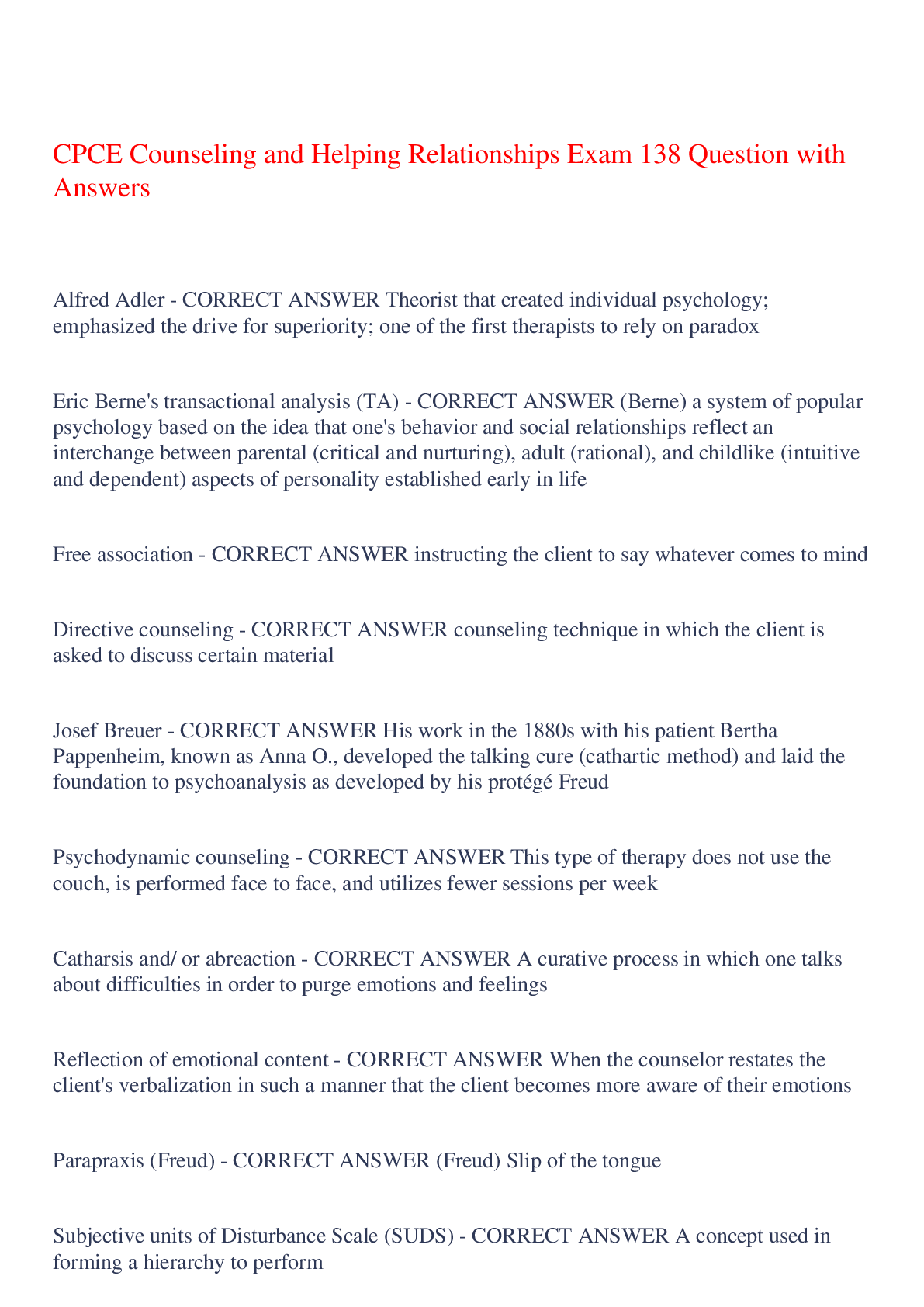
Buy this document to get the full access instantly
Instant Download Access after purchase
Add to cartInstant download
Reviews( 0 )
Document information
Connected school, study & course
About the document
Uploaded On
Jul 27, 2023
Number of pages
13
Written in
Additional information
This document has been written for:
Uploaded
Jul 27, 2023
Downloads
0
Views
36














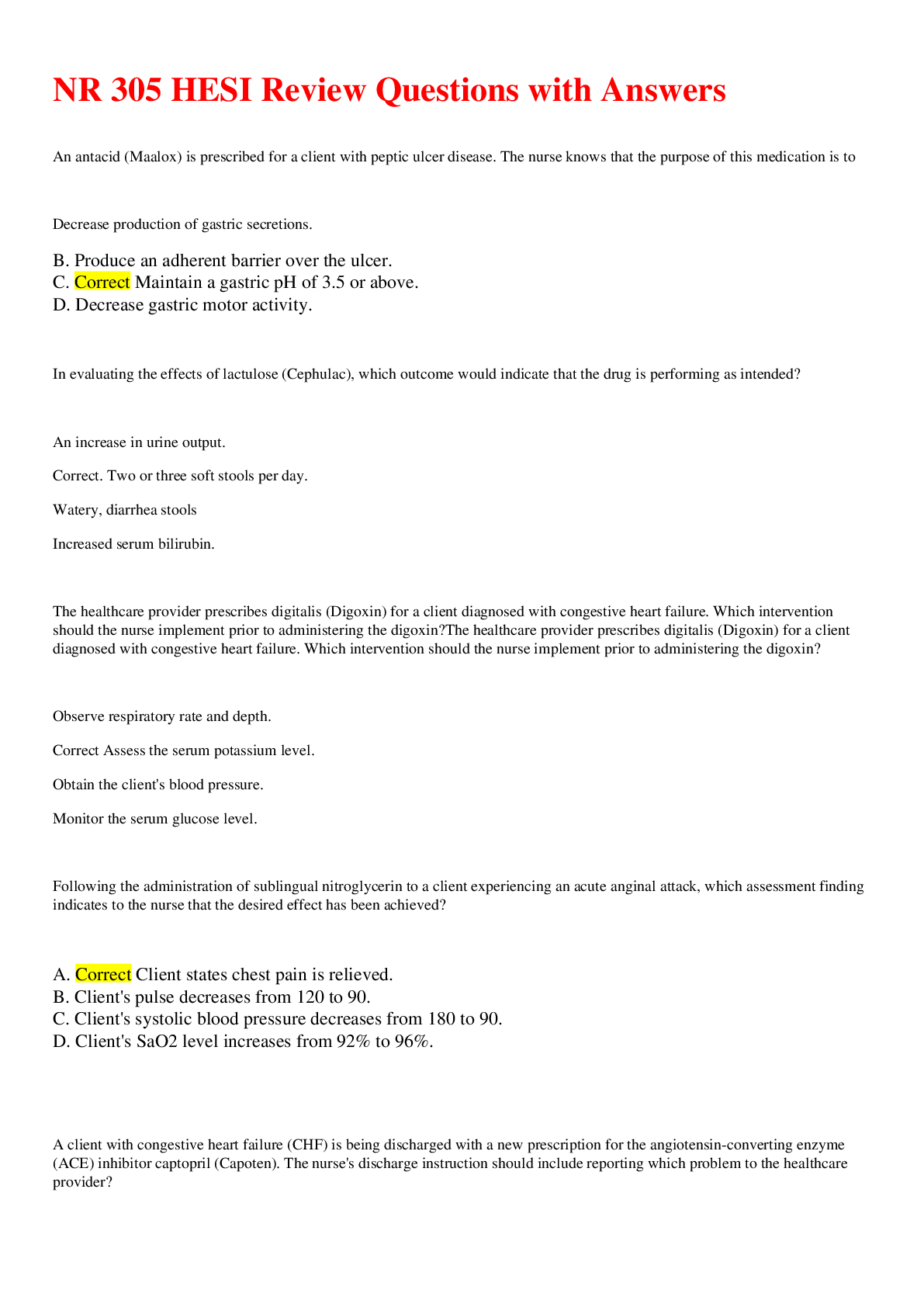
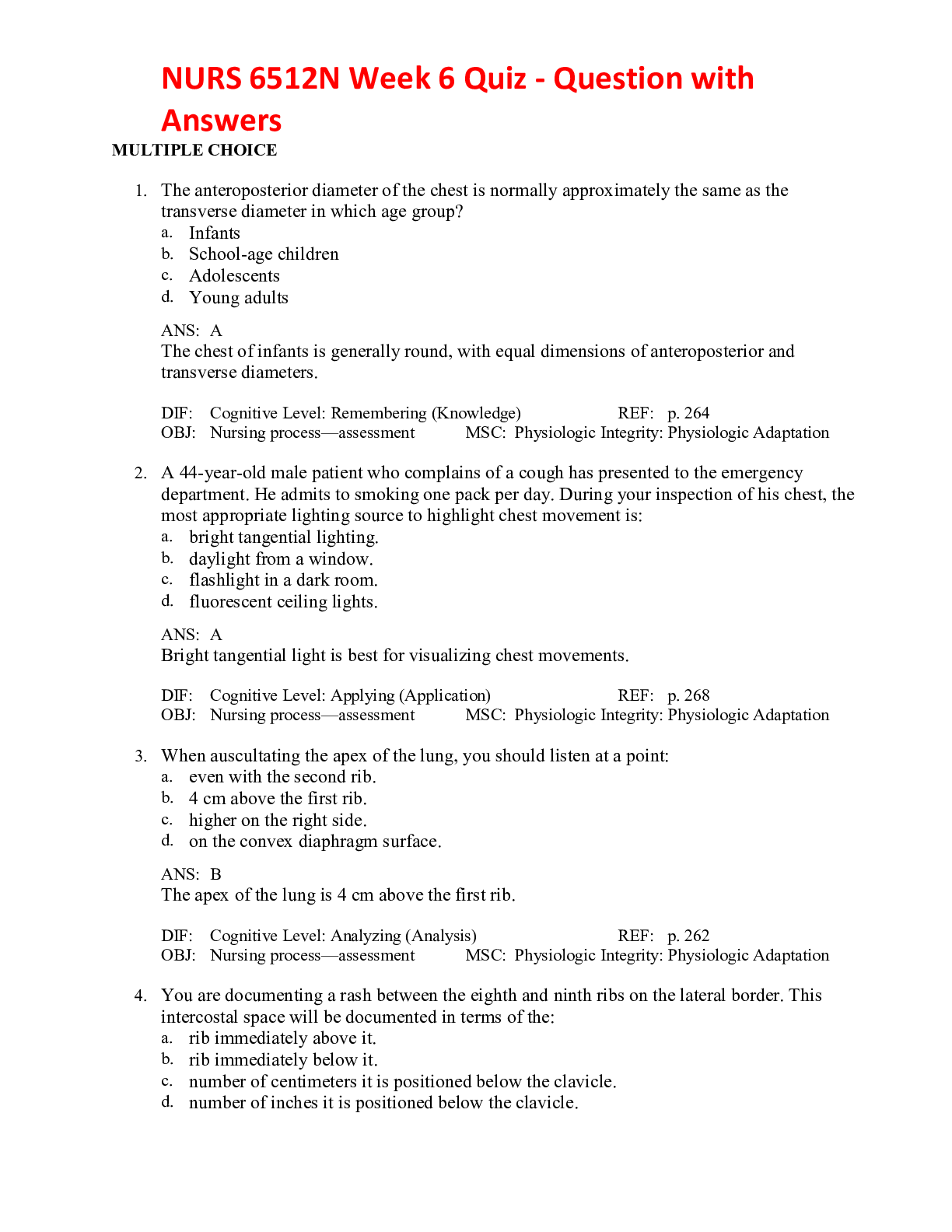
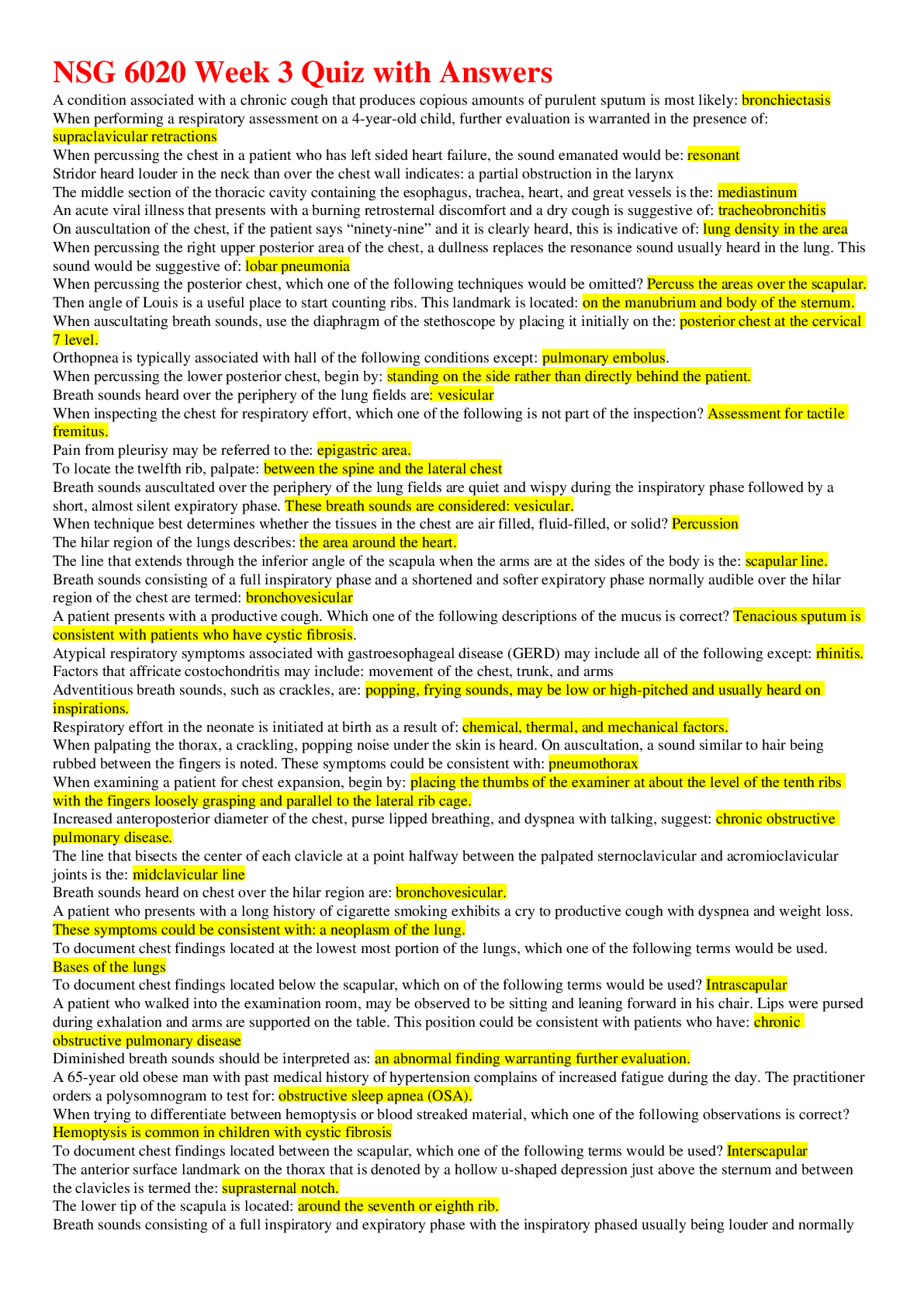
.png)
